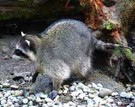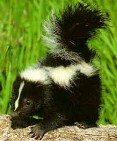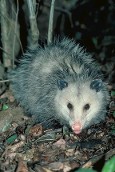| |
The Finest
Pest Control Company in NorthEast, Ohio
Pest Control • Animal Trapping • Chimney Caps/
Exclusions • Termite
Treatments
Pest Identification:
Wildlife |
 |
|
|
(Sciuridae) |
|
|
|
|
 |
|
|
(Latin Name) |
|
|
|
|
 |
|
|
(Latin Name) |
|
|
|
|
 |
|
|
(Leporidae) |
|
|
|
|
 |
|
|
(Squamata) |
|
|
|
|
 |
|
|
(Procyon lotor) |
Characteristics: - 2 - 3 feet long
- Weigh 10 - 30 lbs
- Gray and black in color
- ringed tail and mask around the eyes
History: - A litter of 3 - 5 is produced each year around April and May
- Nocturnal
- Range of 1 - 20 miles
- Omnivores (Feed on both nuts and animals)
- Usually infested with fleas and ticks
- Leading carrier of rabies in US
- Can live in ground burrows, hollow trees, Attics, and other
parts of structures
- Use caution when around
|
|
|
 |
|
|
(Mephitus mephitus) |
Characteristics: - Members of weasel family
- 21- 29 inches long
- Weight 2.2 - 8.0 lbs
- Short stubby legs, well developed claws for digging
- Black with white stripes
- 4 species in US: striped, spotted, hog-nosed, and hooded skunk
History: - Live in areas under porches, decks, underhangs, foundations and
sheds
- They have a range of 1/2 to 2 miles from their home
- They like open areas
- omnivorous (Eat plants & animals)
- Very common to Carry rabies, second to that of raccoons
- Can tear up lawns in search of grubs
- Stomp front feet usually, growl/ hiss when about to spray
- They can spray 20 feet with an accuracy of 10 feet
- They can spray several times within a short period of time
- Can cause temporary blindness for 15 minutes if sprayed in the
eyes
- Odor is on their fur
- Usually do not spray when in dark confined space
- They do not hibernate but may stay in their den for a few days
|
|
|
 |
|
|
(Didelphis virginiana) |
|
|
|
|
 |
|
|
(Scalopus) |
Characteristics: - 5 - 8 inches long
- Weight is 3- 4 ounces
- Gray to silvery gray
- Hairless pointed snout, short tail, and small eyes and ears
hidden by fur
- Front feet are developed for digging
History: - Moles produce 1 litter a year with 3 - 5 young
- Mating occurs in February and March with 6 week gestation
period
- Active during day or night, mostly during spring
- Young will use their families burrows for 6 months before
moving on to develop their territory
- Feed on earthworms, beetles, grubs, ants, and other arthropods
- They may eat seeds and vegetatable matter
- They do not eat plants
|
|
|
 |
|
|
(Tamias striatus or Eutamias minimas) |
|
|
|
|
 |
|
|
(Microtus spp.) |
|
|
|
|
 |
|
|
(Marmota monax) |
|
|
|
|
 |
|
|
(Chiroptera) |
|
|
|
|
 |
|
|
(Soricidae) |
|
|
|
|
|
|
|







